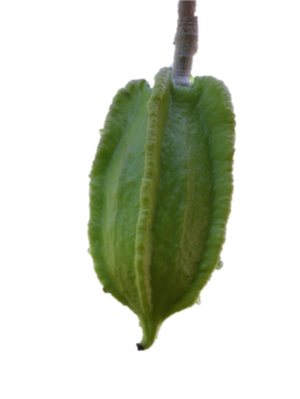Jacaratia mexicana facts for kids
Quick facts for kids Jacaratia mexicana |
|
|---|---|
 |
|
| Scientific classification | |
| Genus: |
Jacaratia
|
| Species: |
mexicana
|
Jacaratia mexicana is a special kind of tree found in warm, dry places. People often call it bonete or K'uun che. It belongs to the same plant family as the papaya, which is called Caricaceae. This tree grows naturally in the tropical dry forests of central and southern Mexico, Nicaragua, and El Salvador.
Contents
About the Bonete Tree
The bonete tree is known for its interesting shape and useful parts. It can grow quite tall, reaching heights of up to 15 meters (about 50 feet). Its trunk is often thick and can store water, helping the tree survive in dry conditions.
Where the Bonete Tree Grows
Bonete trees love warm weather and dry forests. They are often found in areas where there is a clear wet season and a dry season. These trees are common in the lowlands and hills of their native countries. They are an important part of the ecosystem in these tropical dry regions.
What the Bonete Tree Looks Like
The bonete tree has large, lobed leaves that look a bit like a hand with fingers spread out. These leaves can be up to 60 centimeters (about 2 feet) wide. The tree also produces unique fruits.
The Bonete Fruit
The fruit of the bonete tree is quite distinctive. It's shaped like a helmet or a cap, which is why it's called "bonete" (meaning "bonnet" or "cap" in Spanish). The fruit can be yellowish-green when ripe and has a soft, sweet pulp inside. It contains many small, dark seeds.
Uses of the Bonete Tree
The bonete tree is valuable to the local people in the areas where it grows. Different parts of the tree are used for various purposes.
Food and Medicine
The ripe fruit of the bonete tree is edible. People enjoy eating its sweet pulp, which can be a good source of vitamins. In some traditional practices, parts of the tree are also used for their medicinal properties. For example, the sap from the tree is sometimes used to treat certain skin conditions.
Wood and Other Uses
The wood of the bonete tree is lightweight and can be used for making various items. It's not typically used for heavy construction but can be suitable for crafts or other lighter purposes. The tree's presence also helps the environment by providing shade and habitat for animals in dry forest areas.
Life Cycle of the Bonete Tree
Like many trees, the bonete tree starts its life as a seed. Once the seed sprouts, it grows into a young sapling. Over time, it matures into a full-grown tree, capable of producing flowers and fruits.
Reproduction
The bonete tree produces flowers that are pollinated, leading to the development of its unique fruits. These fruits contain seeds, which, when dispersed, can grow into new trees. This cycle allows the bonete tree population to continue thriving in its natural habitat. Animals often help in spreading the seeds, contributing to the tree's reproduction.
See also
 In Spanish: Bonete para niños
In Spanish: Bonete para niños

